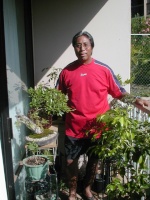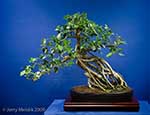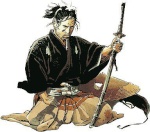Walter Pall Blog Post
+23
efishn
gman
mike page
JimLewis
BonsaiJim
Dan W.
mehrdadchavosh
littleart-fx
gordonb
John Quinn
AlainK
Dustin Mann
Ed Trout
bonsaistud
stavros
Jerry Meislik
Michael T
Jur
Rob Kempinski
Hawaiian77
Kev Bailey
Walter Pall
Victrinia Ridgeway
27 posters
Page 1 of 2
Page 1 of 2 • 1, 2 
 Walter Pall Blog Post
Walter Pall Blog Post
Walter wrote an article for my club's newsletter, and has posted it on his blog.... the subject was originally around conifer fertilization... but he handled the subject from his wholistic approach and included watering and substrates... VERY cool piece of writing!
It's very worth a read... Huge thanks to Walter for being so kind as to provide something of such value to my humble little club.
It goes to the heart of something I've long felt and tried to correct, though not so well as this... That many people often focus on styling - without having sound understanding of horticulture. This just may help clear the waters for some people.
Granted... I think most bonsai growers wouldn't have the time or dedication to put to it that Walter has... but I still see it as something of an ideal. And if the proof is in the pudding.. it works because there is no question about the health or vigor of his trees.
Enjoy!
Victrinia
http://walter-pall-bonsai.blogspot.com/2010/06/feeding-substrate-and-watering-english.html
It's very worth a read... Huge thanks to Walter for being so kind as to provide something of such value to my humble little club.
It goes to the heart of something I've long felt and tried to correct, though not so well as this... That many people often focus on styling - without having sound understanding of horticulture. This just may help clear the waters for some people.
Granted... I think most bonsai growers wouldn't have the time or dedication to put to it that Walter has... but I still see it as something of an ideal. And if the proof is in the pudding.. it works because there is no question about the health or vigor of his trees.
Enjoy!
Victrinia
http://walter-pall-bonsai.blogspot.com/2010/06/feeding-substrate-and-watering-english.html

Victrinia Ridgeway- Member
 Re: Walter Pall Blog Post
Re: Walter Pall Blog Post
We might as well include the whole article and not just the link.
Feeding, Substrate and Watering
Methods of Walter Pall (edited by Victrinia Ridgeway)
I was asked to write a paragraph on the 'feeding of conifers'. So I sat down and came up with this. But the question, “How do you feed conifers?” when given a short answer, can lead to serious misunderstandings and to fatalities.
Substrate, watering and feeding cannot be seen as separate. Each is connected to the other and so it becomes quite complex. Be it a deciduous tree, conifer, young, old, recently potted, or even collected, there are so many variables inside a bonsai garden. Can there be a clear answer?
Well, yes. But one has to read quite carefully and then do EVERYTHING. It is not feasible to pick one that you like and ignore the others. You cannot feed according to my method and don't care what substrate you have or what your watering regime is.
First, I set aside everything that has been written in most bonsai literature about the subject. As technology grants us access to new and more effective methods and products, the way we care for our trees has progressed beyond the boundaries of tradition. It has been a new and modern world for some time, but many have not realized this. Even if some measure of success is achieved with the old methods it can be dangerous if used with modern substrates and practices, or even deadly.
Substrates: Good substrate material must: be of equal particle size, have the ability to absorb water and release it back, have no fine particle organic material, must not decompose easily, be as lightweight as possible when dry, preferably inexpensive and should have an aesthetically pleasing appearance. This would then be: lava, pumice, baked loam, Turface, zeolite, Chabasai (a type of zeolite), coconut pieces, bark pieces, Styrofoam pieces (no joke) and a few more which you can find yourself if you have understood the principles. Please note: Some of these materials may not be available in your area.
Normal akadama is questionable as a good substrate as it inevitably decomposes, especially when exposed to winter frost. It can become deadly loam in the pot, choking the flow of water and air into the soil. This is especially true for trees which are only rarely repotted, like collected conifers and old bonsai in general.
Substrates which are not useful: soil, compost, stones, sand etc. Trees grow in sand and flower soil, of course, but it is not an optimal growing medium for health in bonsai culture.
All substrates can be mixed according to your liking and it makes almost no difference. They can also be recycled and used again, but make certain to sift and clean any recycled materials as needed.
There is no such thing as an 'ideal bonsai substrate'. There are in fact thousands of ideal substrates. I believe that IT DOES NOT MATTER WHAT YOU USE AND IN WHAT MIXTURE as long as it is a modern substrate.
Since there is no soil in modern substrates there is very little alive in them. They dry out easily and one must water several times a day when it is hot, especially if you have used pure inorganics. Therefore I add rough peat in addition to the previously mentioned substrates. This is the kind of peat that is harvested in bogs and comes in its natural coarse form. Make certain not to use fine particle peat/sphagnum moss, even if the package says “dust free” as the particles will be too small. If you cannot find the correct type of peat, use small bark bits without dust particles, or cut coconut fibers. These organic components should comprise 15-20 % of the overall volume, a bit less with conifers, olives and such, and a bit more with small trees and azaleas.
These organic materials are good for keeping humidity higher in the substrate and for supporting the colonization of beneficial microbial life in the soil composition. Research also seems to indicate that peat moss has plant hormones which are good for trees. These are organic materials which would normally have no business being in a bonsai substrate, but the ones mentioned take five years to decompose. You have to consider this when planning your repotting schedules. The organic material should also be sieved out of any substrate that is being recycled.
Watering: I have a watering schedule that runs from the end of March to middle of October EVERY day. This is regardless of whether the trees appear to be dry or not. Only when it rains heavily will I refrain from watering the trees. When it is hot, or there is strong wind, or a combination of the two, I water two or even three times in a day. Very small trees must be watered twice a day. ALL trees are watered the same. Individual watering habits are not needed when all of your trees are in a consistent well draining substrate. There is also no need to carefully train a friend how to water your trees when you are away. Any person can water the trees; everything must only be watered thoroughly. It also does not matter what type of water is used. Tap water is very usable for all plants, even if it is hard water. I have some of the hardest water in Europe in my garden (23° DH). I use this water for everything, including azaleas. I water with a garden hose, full speed. I do not water individual trees, but areas, just like you might water your garden with a sprinkler system.
When you water this way, water aggressively. This means everything becomes very wet, the whole tree from top to bottom. The water must run out of the draining holes. It is very good for the trees if the crown gets wet every day.
With modern substrates over-watering is almost impossible. You can water for hours and all of the excess will just run through the pot if the correct substrate is used. It is very easy to under-water though. Many bonsai die because they are sitting in modern substrate but are watered according to the old methods - under-watered in fact.
Feeding: With modern substrates and aggressive watering, feeding is no secret anymore. ANY fertilizer that is offered for ordinary plants can be used, whether organic or chemical. Fertilizers should have LOTS of nitrogen. Only with nitrogen plants can grow.
I use mainly liquid fertilizer that I get from our cheapest general discount market. In America it would be Walmart. Use general fertilizer that is noted as being good for all plants. In addition I buy a few dozen boxes of granular fertilizers which contain chemical and some organic ingredients. Two times a year, in the beginning of May and in the end of August, I throw a handful of dried chicken manure at the trees. I buy this in large bags, which is very inexpensive. That's it. For ALL of my trees including the world famous ones I use the same fertilizer.
How much? WAY MORE THAN YOU THINK! I feed from 20 to 60 times more than the average bonsai grower. From the beginning of April to the middle of October, every ten days everything is fed with liquid fertilizer, using three to four times the suggested dose. All trees are fed equally, whether deciduous, conifers, small, large, repotted, collected or not. This is a span of about 200 days when the trees are being fed. Since the trees are fed three times the normal dose on twenty days in that time, it makes for 60 doses of fertilizer in the growing season. The average bonsai grower feeds maybe three or five times at half the normal dose because 'bonsai trees should not grow'. If you then add two times a year of chicken manure being given to the trees, you can then understand why this schedule is 20 to 60 times more than the average.
Asian fertilizer cakes are fine but superfluous in our culture. We don't eat steak with chop sticks and don't have to feed plants with cakes. But they don't hurt if you insist of using them; they are just unattractive to look at. Biogold was made to be used with modern substrates like akadama, and it works well. If you give it to me I will break it into very small particles which I then throw all over the substrate surface of the trees. After one watering it becomes invisible.
Too much salt in the substrate is almost impossible if one waters aggressively every day. Even azaleas don't mind my treatment. They thrive very well with very hard water, ordinary baked loam and peat as the substrate and aggressive feeding like all the rest of the trees.
About ten years ago 'super feeding' was proclaimed and a while later forgotten. It did not produce the expected results and many trees suffered and even died. What I do sounds similar. Well, it is similar, only that I insist on aggressive watering in parallel to aggressive feeding and the use of modern substrates. I also don't make the ingredients of fertilizing trees into a science. I tell you to buy whatever is on sale in the garden center or agricultural supply store.
This feeding scheme is for trees in development. Remember that 99.8 % of all bonsai are 'in development'. If you happen to have one that should really not develop anymore you slow down its feeding schedule considerably. You let it starve on purpose. Then it will get smaller, and fewer, leaves and needles. It will look good for shows, but your tree will go downhill if you continue to do this for too long. After a few years you have to feed it aggressively again to let it recover.
Summary: Do all three or nothing! You have no choice here. To just pick one method and refuse the others will end in disaster. Those who do 'super feeding' using old-fashioned soil, and insufficient watering will kill trees. Those who use modern substrates, aggressive watering and fertilizes like the old days will have very weak and, in the end, dead trees. That's all there is to it.
So the question, “How do you feed conifers?” gets the answer, “Like all other trees, but you have to know the whole story.”
I know that many will not believe this. ‘He who heals is right’, is a saying in human medicine. In gardening 'he who has the healthiest trees in the long run' is right. Come to see my garden or look at my gallery, they speak for themselves.
All this was not discovered or invented by me. I only learned from professional modern gardeners. They have done this for decades with great success. I have adapted modern horticulture to bonsai. Only in the bonsai world does this seem revolutionary.
Feeding, Substrate and Watering
Methods of Walter Pall (edited by Victrinia Ridgeway)
I was asked to write a paragraph on the 'feeding of conifers'. So I sat down and came up with this. But the question, “How do you feed conifers?” when given a short answer, can lead to serious misunderstandings and to fatalities.
Substrate, watering and feeding cannot be seen as separate. Each is connected to the other and so it becomes quite complex. Be it a deciduous tree, conifer, young, old, recently potted, or even collected, there are so many variables inside a bonsai garden. Can there be a clear answer?
Well, yes. But one has to read quite carefully and then do EVERYTHING. It is not feasible to pick one that you like and ignore the others. You cannot feed according to my method and don't care what substrate you have or what your watering regime is.
First, I set aside everything that has been written in most bonsai literature about the subject. As technology grants us access to new and more effective methods and products, the way we care for our trees has progressed beyond the boundaries of tradition. It has been a new and modern world for some time, but many have not realized this. Even if some measure of success is achieved with the old methods it can be dangerous if used with modern substrates and practices, or even deadly.
Substrates: Good substrate material must: be of equal particle size, have the ability to absorb water and release it back, have no fine particle organic material, must not decompose easily, be as lightweight as possible when dry, preferably inexpensive and should have an aesthetically pleasing appearance. This would then be: lava, pumice, baked loam, Turface, zeolite, Chabasai (a type of zeolite), coconut pieces, bark pieces, Styrofoam pieces (no joke) and a few more which you can find yourself if you have understood the principles. Please note: Some of these materials may not be available in your area.
Normal akadama is questionable as a good substrate as it inevitably decomposes, especially when exposed to winter frost. It can become deadly loam in the pot, choking the flow of water and air into the soil. This is especially true for trees which are only rarely repotted, like collected conifers and old bonsai in general.
Substrates which are not useful: soil, compost, stones, sand etc. Trees grow in sand and flower soil, of course, but it is not an optimal growing medium for health in bonsai culture.
All substrates can be mixed according to your liking and it makes almost no difference. They can also be recycled and used again, but make certain to sift and clean any recycled materials as needed.
There is no such thing as an 'ideal bonsai substrate'. There are in fact thousands of ideal substrates. I believe that IT DOES NOT MATTER WHAT YOU USE AND IN WHAT MIXTURE as long as it is a modern substrate.
Since there is no soil in modern substrates there is very little alive in them. They dry out easily and one must water several times a day when it is hot, especially if you have used pure inorganics. Therefore I add rough peat in addition to the previously mentioned substrates. This is the kind of peat that is harvested in bogs and comes in its natural coarse form. Make certain not to use fine particle peat/sphagnum moss, even if the package says “dust free” as the particles will be too small. If you cannot find the correct type of peat, use small bark bits without dust particles, or cut coconut fibers. These organic components should comprise 15-20 % of the overall volume, a bit less with conifers, olives and such, and a bit more with small trees and azaleas.
These organic materials are good for keeping humidity higher in the substrate and for supporting the colonization of beneficial microbial life in the soil composition. Research also seems to indicate that peat moss has plant hormones which are good for trees. These are organic materials which would normally have no business being in a bonsai substrate, but the ones mentioned take five years to decompose. You have to consider this when planning your repotting schedules. The organic material should also be sieved out of any substrate that is being recycled.
Watering: I have a watering schedule that runs from the end of March to middle of October EVERY day. This is regardless of whether the trees appear to be dry or not. Only when it rains heavily will I refrain from watering the trees. When it is hot, or there is strong wind, or a combination of the two, I water two or even three times in a day. Very small trees must be watered twice a day. ALL trees are watered the same. Individual watering habits are not needed when all of your trees are in a consistent well draining substrate. There is also no need to carefully train a friend how to water your trees when you are away. Any person can water the trees; everything must only be watered thoroughly. It also does not matter what type of water is used. Tap water is very usable for all plants, even if it is hard water. I have some of the hardest water in Europe in my garden (23° DH). I use this water for everything, including azaleas. I water with a garden hose, full speed. I do not water individual trees, but areas, just like you might water your garden with a sprinkler system.
When you water this way, water aggressively. This means everything becomes very wet, the whole tree from top to bottom. The water must run out of the draining holes. It is very good for the trees if the crown gets wet every day.
With modern substrates over-watering is almost impossible. You can water for hours and all of the excess will just run through the pot if the correct substrate is used. It is very easy to under-water though. Many bonsai die because they are sitting in modern substrate but are watered according to the old methods - under-watered in fact.
Feeding: With modern substrates and aggressive watering, feeding is no secret anymore. ANY fertilizer that is offered for ordinary plants can be used, whether organic or chemical. Fertilizers should have LOTS of nitrogen. Only with nitrogen plants can grow.
I use mainly liquid fertilizer that I get from our cheapest general discount market. In America it would be Walmart. Use general fertilizer that is noted as being good for all plants. In addition I buy a few dozen boxes of granular fertilizers which contain chemical and some organic ingredients. Two times a year, in the beginning of May and in the end of August, I throw a handful of dried chicken manure at the trees. I buy this in large bags, which is very inexpensive. That's it. For ALL of my trees including the world famous ones I use the same fertilizer.
How much? WAY MORE THAN YOU THINK! I feed from 20 to 60 times more than the average bonsai grower. From the beginning of April to the middle of October, every ten days everything is fed with liquid fertilizer, using three to four times the suggested dose. All trees are fed equally, whether deciduous, conifers, small, large, repotted, collected or not. This is a span of about 200 days when the trees are being fed. Since the trees are fed three times the normal dose on twenty days in that time, it makes for 60 doses of fertilizer in the growing season. The average bonsai grower feeds maybe three or five times at half the normal dose because 'bonsai trees should not grow'. If you then add two times a year of chicken manure being given to the trees, you can then understand why this schedule is 20 to 60 times more than the average.
Asian fertilizer cakes are fine but superfluous in our culture. We don't eat steak with chop sticks and don't have to feed plants with cakes. But they don't hurt if you insist of using them; they are just unattractive to look at. Biogold was made to be used with modern substrates like akadama, and it works well. If you give it to me I will break it into very small particles which I then throw all over the substrate surface of the trees. After one watering it becomes invisible.
Too much salt in the substrate is almost impossible if one waters aggressively every day. Even azaleas don't mind my treatment. They thrive very well with very hard water, ordinary baked loam and peat as the substrate and aggressive feeding like all the rest of the trees.
About ten years ago 'super feeding' was proclaimed and a while later forgotten. It did not produce the expected results and many trees suffered and even died. What I do sounds similar. Well, it is similar, only that I insist on aggressive watering in parallel to aggressive feeding and the use of modern substrates. I also don't make the ingredients of fertilizing trees into a science. I tell you to buy whatever is on sale in the garden center or agricultural supply store.
This feeding scheme is for trees in development. Remember that 99.8 % of all bonsai are 'in development'. If you happen to have one that should really not develop anymore you slow down its feeding schedule considerably. You let it starve on purpose. Then it will get smaller, and fewer, leaves and needles. It will look good for shows, but your tree will go downhill if you continue to do this for too long. After a few years you have to feed it aggressively again to let it recover.
Summary: Do all three or nothing! You have no choice here. To just pick one method and refuse the others will end in disaster. Those who do 'super feeding' using old-fashioned soil, and insufficient watering will kill trees. Those who use modern substrates, aggressive watering and fertilizes like the old days will have very weak and, in the end, dead trees. That's all there is to it.
So the question, “How do you feed conifers?” gets the answer, “Like all other trees, but you have to know the whole story.”
I know that many will not believe this. ‘He who heals is right’, is a saying in human medicine. In gardening 'he who has the healthiest trees in the long run' is right. Come to see my garden or look at my gallery, they speak for themselves.
All this was not discovered or invented by me. I only learned from professional modern gardeners. They have done this for decades with great success. I have adapted modern horticulture to bonsai. Only in the bonsai world does this seem revolutionary.

Walter Pall- Member
 Re: Walter Pall Blog Post
Re: Walter Pall Blog Post
Very interesting Walter. Thanks for posting it here.
I can see that my feeding regime is too conservative. Soil and watering practice is similar to yours, so I'll start experimenting with increased doses. I use the dried chicken manure already.
I can see that my feeding regime is too conservative. Soil and watering practice is similar to yours, so I'll start experimenting with increased doses. I use the dried chicken manure already.

Kev Bailey- Admin
 Re: Walter Pall Blog Post
Re: Walter Pall Blog Post
Mahalo Walter for the information. It has open my eyes a bit.
A Hui Hou,
-Tim
A Hui Hou,
-Tim

Hawaiian77- Member
 Re: Walter Pall Blog Post
Re: Walter Pall Blog Post
Great article. The most important point about the article is to think about your horticultural practice in a wholistic sense and water and fertilize from there. Do not blindly follow someone's advice without thinking about why.
I believe three other factors are important in watering - soil particle size, ambient temperature and root mass density. They are related as a triad. I included a figure in my book to try to explain this.
I use smaller particles in my shohin trees.
Local conditions can make a difference. In Florida in the summer it can go weeks where it rains hard virtually every day for an hour or so. Well draining inorganic soil mix as Walter mentions is critical for us. However, one exception, I don't use any organic component. The pines would stay too wet. Sometimes in a real monsoon season, even with the inorganic mix, I need to protect my confiers from rain. There is one major exception, Bald Cypress is a conifer that can take and will enjoy as much water as you can give it. I add lots of organic content to Bald Cypress soil mix to help keep it wet.
As for fertilzer, I use almost exlcusively Miracle Grow granular fertilizer. Placing lots on the soil means every time the trees are watered there is fertilizer availble for the trees. With our long growing season I palce the Miracle grow year round. The light green color doeswn't look too bad. Once in a while I apply liquid fertilizer but rarely as its takes too long to give it to all my trees.
I believe three other factors are important in watering - soil particle size, ambient temperature and root mass density. They are related as a triad. I included a figure in my book to try to explain this.
I use smaller particles in my shohin trees.
Local conditions can make a difference. In Florida in the summer it can go weeks where it rains hard virtually every day for an hour or so. Well draining inorganic soil mix as Walter mentions is critical for us. However, one exception, I don't use any organic component. The pines would stay too wet. Sometimes in a real monsoon season, even with the inorganic mix, I need to protect my confiers from rain. There is one major exception, Bald Cypress is a conifer that can take and will enjoy as much water as you can give it. I add lots of organic content to Bald Cypress soil mix to help keep it wet.
As for fertilzer, I use almost exlcusively Miracle Grow granular fertilizer. Placing lots on the soil means every time the trees are watered there is fertilizer availble for the trees. With our long growing season I palce the Miracle grow year round. The light green color doeswn't look too bad. Once in a while I apply liquid fertilizer but rarely as its takes too long to give it to all my trees.

Rob Kempinski- Member
 Re: Walter Pall Blog Post
Re: Walter Pall Blog Post
Victrinia, thanks a lot, you motivate Pall to write such an interesting and useful article! 
Many thanks directly to Walter.
Many thanks directly to Walter.
Last edited by Jur on Thu Jun 17, 2010 11:52 pm; edited 1 time in total
Jur- Member
 Re: Walter Pall Blog Post
Re: Walter Pall Blog Post
I think the thing which is most wonderful about this article is that it puts in focus the things which I believe bonsai has been trending towards. Most of us do some of it, few of us do all of it. As Rob so aptly points out, there are even more details to consider, but this is a foundation to getting where you want to be. Looking at Walter's progressions, it's not hard to understand how he accomplishes such amazing work when seen through the lens of his care regimine.
But it also plainly states the potential risks of only doing parts of this regimine. To channel the inner Yoda that Alain was doing the other day...
Do, or do not. There is no 'try'.
Kindest regards,
Victrinia
But it also plainly states the potential risks of only doing parts of this regimine. To channel the inner Yoda that Alain was doing the other day...
Do, or do not. There is no 'try'.

Kindest regards,
Victrinia

Victrinia Ridgeway- Member
 Re: Walter Pall Blog Post
Re: Walter Pall Blog Post
Walter,
I find your discussion very, very worthwhile and should be followed, with comprehension, by all bonsai growers.
Jerry
www.bonsaihunk.us
I find your discussion very, very worthwhile and should be followed, with comprehension, by all bonsai growers.
Jerry
www.bonsaihunk.us

Jerry Meislik- Member
 Re: Walter Pall Blog Post
Re: Walter Pall Blog Post
One major consideration is the fact that many trees have a rootball that may contain soil (yamadori) or substrate that broke down (especially trees from Japan with akadama that brakes down).
I understand that one must replace this with a modern substrate as the ones Walter is talking about. Sometimes, especially in conifers this is a bit of an issue as you must do it in a stepped manner.
Can anyone give some insight on this? (replacing old soil from the rootball)
Thanks
I understand that one must replace this with a modern substrate as the ones Walter is talking about. Sometimes, especially in conifers this is a bit of an issue as you must do it in a stepped manner.
Can anyone give some insight on this? (replacing old soil from the rootball)
Thanks
stavros- Member
 Re: Walter Pall Blog Post
Re: Walter Pall Blog Post
G'day Ms Vic...and Walter...
Thank you so much M'Lady for initiating this thread.
And Walter...what an outstanding "paragraph", which, I find, relates very well to your 60X use of fertilizer. For a number of years I have been been using, as you suggest, same soil, same fert, same watering for all of my plants. I am now going to study your "paragraph" and determine how I may redefine my soil/fert/water process. Your "60X" suggestion...not sure just how far I'll go, but I will definitley get more aggresive with fertilizing.
Again, thank you my friends, for this wonderful "paragraph".
Pat…mounted on my trusty stead, riding off wildly in all directions…
Thank you so much M'Lady for initiating this thread.
And Walter...what an outstanding "paragraph", which, I find, relates very well to your 60X use of fertilizer. For a number of years I have been been using, as you suggest, same soil, same fert, same watering for all of my plants. I am now going to study your "paragraph" and determine how I may redefine my soil/fert/water process. Your "60X" suggestion...not sure just how far I'll go, but I will definitley get more aggresive with fertilizing.
Again, thank you my friends, for this wonderful "paragraph".
Pat…mounted on my trusty stead, riding off wildly in all directions…

bonsaistud- Member
 Re: Walter Pall Blog Post
Re: Walter Pall Blog Post
lol... Pat you can only image my surprised delight when I opened the document which contained said "paragraph".
Warmest regards,
Victrinia
Warmest regards,
Victrinia

Victrinia Ridgeway- Member
 Re: Walter Pall Blog Post
Re: Walter Pall Blog Post
Thank You Victrinia & Walter,
I am happy to say that I have been using your suggested method of watering and fertilizing for over 35 years. IT WORKS ! Many of the personal bonsai collections I visit are underwatered & not fertilized enough, and their trees do not look vibrant. When trees are happy, they will show it !!
Ed Trout Pembroke Pines, Florida zone 10c
I am happy to say that I have been using your suggested method of watering and fertilizing for over 35 years. IT WORKS ! Many of the personal bonsai collections I visit are underwatered & not fertilized enough, and their trees do not look vibrant. When trees are happy, they will show it !!
Ed Trout Pembroke Pines, Florida zone 10c
Ed Trout- Member
 Re: Walter Pall Blog Post
Re: Walter Pall Blog Post
Good concise discussion. Thanks Victrinia(and of course Walter). Reinforcing. I fertilize about every 3 days(11mo./yr) with fish emulsion and use either 100% or 80ish% red and black lava rock past 15yrs. Dustin Mann
Dustin Mann- Member
 Re: Walter Pall Blog Post
Re: Walter Pall Blog Post
Very sound advice for most of us Europeans, an excellent reference based on experience and common sense.
Grumph.

Grumph.

AlainK- Member
 Re: Walter Pall Blog Post
Re: Walter Pall Blog Post
Good advice...I have automated emails sent to me to remind me to fertilize every two weeks...I also use Miracle Grow (though just full strength or a little more) or similar, and sometimes the time release as Rob mentioned. My dogs find anything organic smelling too interesting!

John Quinn- Member
 Re: Walter Pall Blog Post
Re: Walter Pall Blog Post
I followed a link [was it on AusBonsai site??] to this article on a German site, and a translation somewhere else. The translation was from someone who had English as a second language, and it missed a lot of idiom, and had a few bits I couldn't work out. I ran it past my sister, who has some German language, and came up with something resembling English.
This, however, is much more enjoyable to read, and will replace the 'translated' version I have.
Thanks Walter, and Victrinia.
This, however, is much more enjoyable to read, and will replace the 'translated' version I have.
Thanks Walter, and Victrinia.
gordonb- Member
 Re: Walter Pall Blog Post
Re: Walter Pall Blog Post
What can i say,.....
As in first stages and steps......of keeping them up.
And yes there are a lot doses of feel to it.
Concrete in the world of jungle.
As it is logic to approach the feel of agriculture.......
I only have a few,.....
Chicken shit,.....may i ad beer.....they thrive......why?
If a tree has to be in colour (junipers) chicken shit and beer!
came accros some weird things i tried.....it worked!
Whalter Thnx!
As in first stages and steps......of keeping them up.
And yes there are a lot doses of feel to it.
Concrete in the world of jungle.
As it is logic to approach the feel of agriculture.......
I only have a few,.....
Chicken shit,.....may i ad beer.....they thrive......why?
If a tree has to be in colour (junipers) chicken shit and beer!
came accros some weird things i tried.....it worked!
Whalter Thnx!

littleart-fx- Member
 Re: Walter Pall Blog Post
Re: Walter Pall Blog Post
Thank you so much Victirina & Walter, what a article, remember once I mentioned chicken manure in our club as a fertilizer as I have read in Walter's blog before , and every body disagreed with me , but now it's clear to me what he means by terms of using chicken manure , I should print this & give to our club members , I myself ,will follow this article anyway.
Thanks again .
Mehrdad
Thanks again .
Mehrdad

mehrdadchavosh- Member
 Re: Walter Pall Blog Post
Re: Walter Pall Blog Post
Walter, could I have permission to re-print this article for our club?

Dan W.- Member
 Re: Walter Pall Blog Post
Re: Walter Pall Blog Post
Dan W. wrote:Walter, could I have permission to re-print this article for our club?
Sure Dan, go ahead.

Walter Pall- Member
 Re: Walter Pall Blog Post
Re: Walter Pall Blog Post
Walter,
I am doing pretty much the same thing after going through the "SuperFeeding" phase myself. I have the need to water excessively due to the TX heat- its necessary to cool the roots at some point in the day regardless of whether the plant "needs water" or not.
I used inorganic mixes (Haydite, turface, expanded shale "soil conditioners", brick chips- whatever I could find) when I had an automatic watering system and had great results even with a constant salt-laden sea breeze to contend with. I moved to the country and began hand-watering as needed and everything fell apart. I began changing my soil mix, got lax about fertilizing as well and further problems was the result.
So, I return to what I know worked... I still have trees that I have to transition to my old system (I even did "drill and fill" on some to get them closer earlier this summer) and I do see results almost immediately.
I depart from your methodology in that I use goat manure (aka "goat berries") as I have a near endless supply thanks to my wife's business. Old Nick Lenz trick (he used rabbit manure).
If a tree dies from "overwatering" in this system it is more than likely a fault of some other factor that damaged the roots- improper repotting aftercare, baked it in the hot sun due to my screw-up, something damaged it, etc...
I am doing pretty much the same thing after going through the "SuperFeeding" phase myself. I have the need to water excessively due to the TX heat- its necessary to cool the roots at some point in the day regardless of whether the plant "needs water" or not.
I used inorganic mixes (Haydite, turface, expanded shale "soil conditioners", brick chips- whatever I could find) when I had an automatic watering system and had great results even with a constant salt-laden sea breeze to contend with. I moved to the country and began hand-watering as needed and everything fell apart. I began changing my soil mix, got lax about fertilizing as well and further problems was the result.
So, I return to what I know worked... I still have trees that I have to transition to my old system (I even did "drill and fill" on some to get them closer earlier this summer) and I do see results almost immediately.
I depart from your methodology in that I use goat manure (aka "goat berries") as I have a near endless supply thanks to my wife's business. Old Nick Lenz trick (he used rabbit manure).
If a tree dies from "overwatering" in this system it is more than likely a fault of some other factor that damaged the roots- improper repotting aftercare, baked it in the hot sun due to my screw-up, something damaged it, etc...

BonsaiJim- Member
 Re: Walter Pall Blog Post
Re: Walter Pall Blog Post
Thanks for reviving this old thread, Jim.
Walter's piece needed to be re-read by several of us (or for newer members -- read).
Walter's piece needed to be re-read by several of us (or for newer members -- read).

JimLewis- Member
 Re: Walter Pall Blog Post
Re: Walter Pall Blog Post
Walter said:
"Normal akadama is questionable as a good substrate as it inevitably decomposes, especially when exposed to winter frost. It can become deadly loam in the pot, choking the flow of water and air into the soil. This is especially true for trees which are only rarely repotted, like collected conifers and old bonsai in general."
Thank you Walter. I agree with you 100%. I've never used akadama for the reasons you have stated above.
Crushed lava, 1/8" to 1/4" is my main substrate. To this I add about 40% Dyna-rok. I user this combination for all my bonsai. It works very well.
"Normal akadama is questionable as a good substrate as it inevitably decomposes, especially when exposed to winter frost. It can become deadly loam in the pot, choking the flow of water and air into the soil. This is especially true for trees which are only rarely repotted, like collected conifers and old bonsai in general."
Thank you Walter. I agree with you 100%. I've never used akadama for the reasons you have stated above.
Crushed lava, 1/8" to 1/4" is my main substrate. To this I add about 40% Dyna-rok. I user this combination for all my bonsai. It works very well.

mike page- Member
Page 1 of 2 • 1, 2 
 Similar topics
Similar topics» INTERNATIONAL BONSAI ACADEMY with Walter Pall - The Plato's Cave Analogy
» My Broom Celtis
» Thoughts with Walter Pall
» Walter Pall to visit Michigan
» American Bonsai at the NC Arboretum
» My Broom Celtis
» Thoughts with Walter Pall
» Walter Pall to visit Michigan
» American Bonsai at the NC Arboretum
Page 1 of 2
Permissions in this forum:
You cannot reply to topics in this forum






